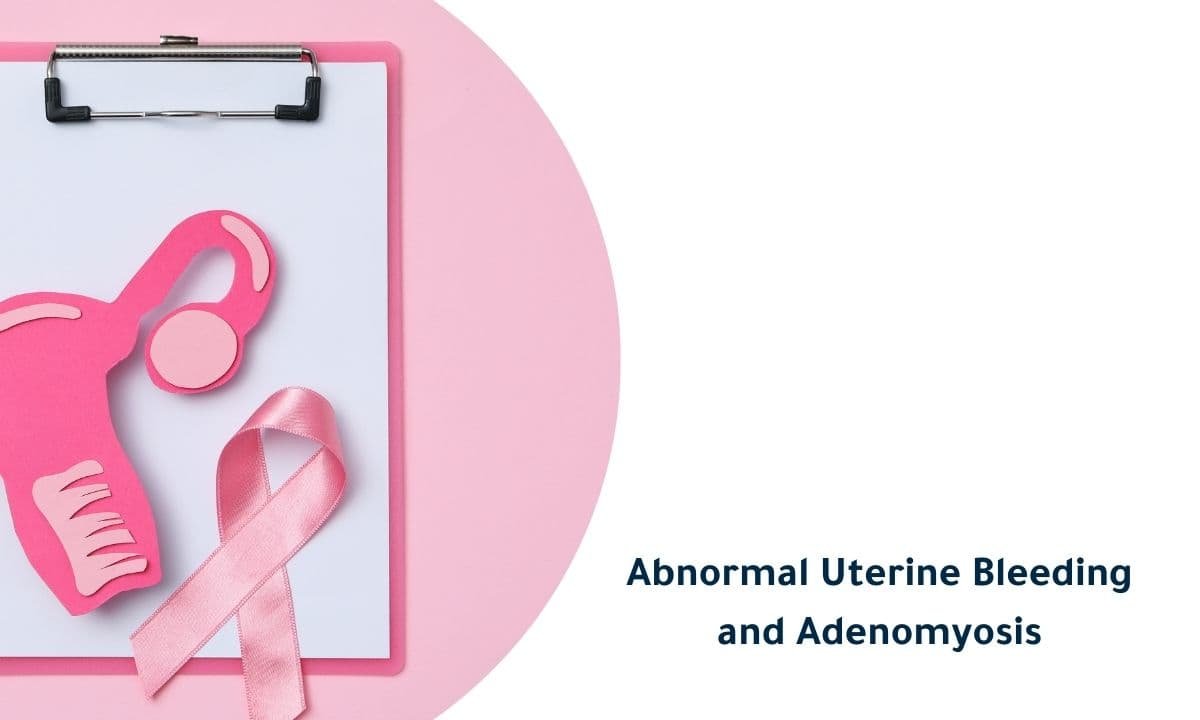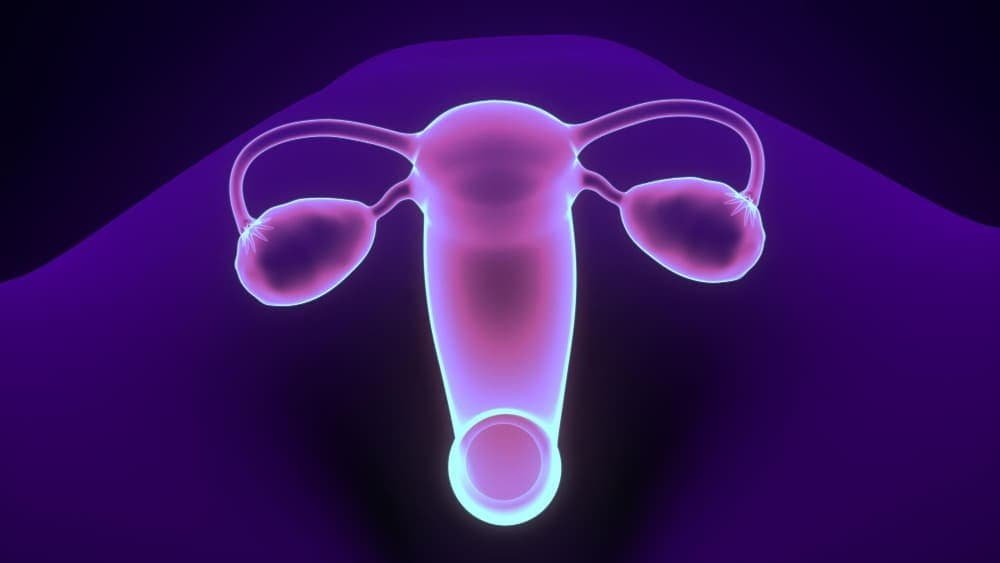Abnormal uterine bleeding (AUB) is a common issue that many women face, significantly impacting their daily lives. One condition that can cause Abnormal uterine bleeding is adenomyosis. This occurs when the tissue lining the uterus grows into the uterine wall, leading to heavy, painful periods and an enlarged uterus.
This article aims to illuminate the complex relationship between abnormal uterine bleeding and adenomyosis, exploring its causes, symptoms, diagnosis, and the range of treatment options available. Whether you’re struggling with these issues or simply seeking to understand them better, this guide will provide valuable insights into navigating this challenging condition.

Abnormal Uterine Bleeding and Adenomyosis
Abnormal uterine bleeding (AUB) can be a significant disruption in a woman’s life. It refers to any bleeding from the uterus that is irregular in frequency, duration, or amount. One common cause of AUB is adenomyosis. Let’s break down what this condition is and how it affects you.
What is Adenomyosis?
Adenomyosis occurs when the endometrial tissue, which normally lines the uterus, grows into the uterine wall (myometrium). This can cause the uterus to enlarge and lead to painful, heavy periods. Imagine the walls of your uterus becoming thicker and filled with blood—sounds uncomfortable, right? 😣
Symptoms to Watch For
Women with adenomyosis often experience:
- Heavy menstrual bleeding (menorrhagia)
- Painful periods (dysmenorrhea) 🩸
- Chronic pelvic pain
- Irregular menstrual cycles 📅
These symptoms can vary from person to person, making diagnosing difficult. Some might have frequent spotting between periods, while others may have severe cramps and a prolonged menstrual cycle.
Commonly Linked Conditions
Adenomyosis is sometimes found alongside other conditions like uterine fibroids, polyps, and endometriosis. These structural abnormalities can also cause similar symptoms, making diagnosis even more complex.
Diagnosis and Treatment
To diagnose adenomyosis, doctors often use ultrasound or MRI. These imaging techniques can reveal the presence of endometrial tissue within the uterine muscle. Once diagnosed, treatment options include:
- Medication: To manage pain and reduce heavy bleeding.
- Hormonal Therapy: To regulate the menstrual cycle and shrink adenomyotic tissue.
- Surgery: In severe cases, procedures like uterine artery embolization or even hysterectomy might be considered.
Uterine Artery Embolization for Adenomyosis
UAE is a minimally invasive procedure that targets the blood supply to the adenomyotic tissue. By blocking the uterine arteries, the blood flow to the adenomyosis is reduced, causing the abnormal tissue to shrink and symptoms to improve. This procedure is performed under imaging guidance, typically using ultrasound or MRI, ensuring precision and safety.
How Does UAE Work?
During the procedure, a catheter is inserted into the femoral artery and guided to the uterine arteries. Small particles are then injected to block the blood flow, leading to a reduction in the size of the adenomyotic tissue. This process alleviates symptoms like heavy menstrual bleeding, anemia, and severe cramps, allowing women to regain control over their reproductive health.
Benefits of UAE
- Minimally Invasive: Unlike traditional surgery, UAE requires no large incisions, leading to a quicker recovery time.
- Effective Symptom Relief: Studies show significant improvement in symptoms such as prolonged periods, irregular bleeding, and chronic pelvic pain.
- Preservation of Uterus: UAE preserves the uterus, which is crucial for women who wish to maintain their reproductive potential.
Who Can Benefit from UAE?
UAE is an excellent option for women with adenomyosis who experience symptoms like heavy, prolonged periods, severe cramps, and anemia. It is also beneficial for those who want to avoid major surgery or who are not candidates for hormonal treatments.
Understanding and Managing Adenomyosis
Adenomyosis can be a challenging condition, but with proper diagnosis and a personalized treatment plan, patients can find relief and improve their quality of life. If you experience symptoms like abnormal bleeding, severe menstrual pain, or chronic pelvic pain, it’s essential to seek medical advice. Early intervention can help manage symptoms effectively and improve overall well-being. 💪
FAQS
What Happens if Adenomyosis is Left Untreated?
If adenomyosis is left untreated, it can lead to a variety of complications and significantly impact a woman’s quality of life. The most common issues include:
- Chronic Pelvic Pain: Adenomyosis often causes persistent pelvic pain due to the presence of endometrial tissue within the uterine wall (myometrium). This pain can become more intense and chronic over time.
- Heavy and Prolonged Menstrual Bleeding: Untreated adenomyosis can result in abnormal menses, including heavy and prolonged periods. This excessive bleeding can lead to anemia, a condition where the blood lacks enough healthy red blood cells, causing fatigue and weakness.
- Enlargement of the Uterus: The condition can cause the uterus to grow larger, leading to pelvic pressure and discomfort. An enlarged uterus can also result in irregular menstrual cycles and severe cramps.
- Impact on Fertility: Adenomyosis can lead to subfertility or difficulty in becoming pregnant. The condition may interfere with the normal function of the uterus, making it challenging for patients to conceive.
- Increased Risk of Other Conditions: Adenomyosis is often associated with other gynecological conditions such as endometriosis and leiomyomas (uterine fibroids). The presence of these conditions can complicate the clinical picture and lead to additional symptoms.
What are the Four Stages of Adenomyosis?
Adenomyosis does not have universally defined stages like some other conditions, but it can be classified based on the depth of invasion into the myometrium. Here’s a commonly used classification:
- Stage 1: Minimal Adenomyosis
- The endometrial tissue grows just into the inner one-third of the myometrium.
- Symptoms are typically mild and may include occasional pelvic pain and irregular periods.
- Stage 2: Mild Adenomyosis
- The tissue invades up to the middle third of the myometrium.
- Patients may experience more noticeable symptoms such as heavier menstrual bleeding and more frequent cramps.
- Stage 3: Moderate Adenomyosis
- The endometrial tissue extends into the outer third of the myometrium.
- This stage often presents with chronic pelvic pain, significant menstrual irregularities, and an enlarged uterus.
- Stage 4: Severe Adenomyosis
- The tissue fully invades the entire myometrium.
- Symptoms are severe, including chronic pain, very heavy and prolonged menstrual bleeding, and a significantly enlarged uterus. This stage can lead to major impacts on daily life and overall health, including severe anemia and potential subfertility.
How Does Adenomyosis Cause Abnormal Uterine Bleeding?
Adenomyosis is a condition where the endometrial tissue, which lines the inside of the uterus, grows into the muscle wall of the uterus (myometrium). This abnormal growth can cause significant changes in the uterus, leading to abnormal uterine bleeding (AUB). Here’s how it happens:
- Enlargement and Thickening: The presence of endometrial tissue within the myometrium causes the uterus to enlarge and thicken. This enlargement disrupts the normal menstrual cycle, leading to heavier and prolonged periods.
- Increased Blood Flow: The embedded endometrial tissue continues to function as it normally would during the menstrual cycle. This means it thickens, breaks down, and bleeds. However, because it’s trapped in the muscle layer, the bleeding is more severe and lasts longer than typical menstrual bleeding.
- Chronic Inflammation: The continual cycle of bleeding and healing within the myometrium causes chronic inflammation. This inflammation can lead to severe cramps and increased bleeding during menses.
- Muscle Wall Changes: The muscle layer of the uterus (myometrium) becomes less flexible and more fibrous due to the presence of adenomyotic tissue. This change in the uterine wall can make menstrual blood flow abnormally, contributing to irregular and heavy bleeding.
How Do You Treat Adenomyosis Bleeding?
Treating adenomyosis bleeding involves several approaches, depending on the severity of symptoms and the patient’s overall health and reproductive goals. Here are some common treatments:
- Medication:
- Nonsteroidal Anti-Inflammatory Drugs (NSAIDs): These help reduce pain and inflammation.
- Hormonal Therapy: Birth control pills, progestin therapy, and intrauterine devices (IUDs) can help regulate the menstrual cycle and reduce bleeding.
- Surgical Options:
- Uterine Artery Embolization (UAE): This procedure reduces blood flow to the adenomyotic tissue, causing it to shrink and reducing bleeding. 🏥
- Endometrial Ablation: This removes or destroys the lining of the uterus, which can help control heavy bleeding.
- Hysterectomy: In severe cases, removing the uterus may be recommended. This is a definitive cure for adenomyosis but is usually considered when other treatments fail and if childbearing is not desired.
- Lifestyle Changes:
- Diet and Exercise: Maintaining a healthy lifestyle can help manage symptoms. Reducing stress and keeping a balanced diet may improve overall health and well-being.
- Alternative Therapies:
- Some patients find relief through acupuncture, herbal supplements, and other complementary treatments. Always consult with a healthcare provider before starting any alternative therapy. 🌿
It’s essential for patients to consult with their healthcare provider to determine the most appropriate treatment plan based on their individual needs and medical history.
Remember, you’re not alone. Many women face these issues, and support is available.

 العربية
العربية 


